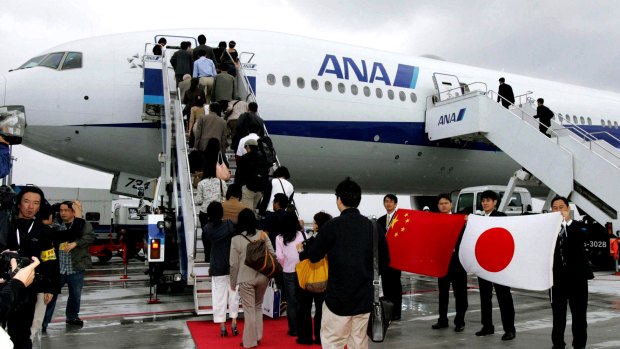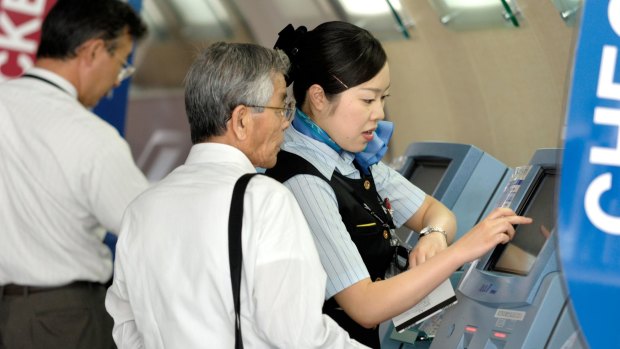This was published 5 years ago
Best plane boarding systems: ANA's simple idea is brilliant
By Ben Groundwater

ANA has created the world's easiest boarding system. Credit: Alamy
You might think getting on a plane would be simple. A uniform procedure, in fact. But you'd be wrong.
It seems like every airline has a different boarding system, its own convoluted arrangement of groups and priorities, its own method of reducing queuing and rewarding customers. But not all are created equal. There are two ends of the scale, in terms of efficiency and joy, that I've experienced.
The first is EasyJet, back before 2012, when boarding the plane was an absolute free-for-all. No seats were assigned. No groups were made. You just got a boarding pass that allowed you entry to the plane. From there, where you sat was up to you. Ryanair had the same system.

An ANA staff member helps a passenger at self-serve check-in.Credit: Alamy
That resulted in mad rushes from the gate to the plane, in which people pushed and shoved and ran on the tarmac. It also resulted in the inevitable sale of plenty of "queue jump" passes – so many, in fact, that the whole thing was rendered pointless because almost everyone had one. Back to the pushing and shoving.
That was the worst boarding procedure I've experienced. Jetstar briefly did it in Australia, too, but it was wildly unpopular. Easyjet and Ryanair both scrapped it earlier this decade. You can't just let people fight it out for the good seats once they get on board. It's chaos. No one is happy.
On the opposite end of the scale: ANA. On the Japanese carrier's domestic flights, those sitting at the back of the plane, and – crucially – those sitting in window seats, board the plane first (or at least, after the priority passengers). Then, those sitting towards the front and those in aisle seats get on board.
Such a simple but brilliant idea. Obviously, people in window seats should get on first, to avoid others having to get up and let you in and slow down the whole procedure. And, just as obviously, those in the aisle seats should get on last, so they can just slip into their spots and away we go.
Couple that with the politeness and adherence to queueing etiquette that you always find in Japan and you have one of the slickest boarding procedures around. In fact, I can't think of a better one.
How is this such a hard thing to get right? Boarding a plane should be as easy as lining up and then getting on – you have a seat assigned already; no one is going to steal your spot – but people are always nervous and pushy, and each airline seems to have a different system, a system that ranges from an orderly shuffle towards the gate to a full-on scrum to be first to the front.
Nothing about this is by chance, either. Every airline carefully plans the way it gets passengers onto its planes: the faster the better for these guys, because the quicker the turnaround, the more flights they're able to operate, and the more money they can make.
But some are more successful, and complex, than others. If you travel in Australia, you'll be used to a fairly simple system across the board, with business and priority customers called first, and then a mass shuffle towards the gates for everyone else in economy. Sometimes they call those seated in the back rows first, but judging by the number of people already sitting in the front half of the plane by the time you board, this seems more like an "honour system" rather than something that is actually enforced. It works, but it isn't efficient, and it could be a lot better.
LATAM, in South America, splits its boarding queues into four or five lines, going by row number – the further back you sit, the earlier you get on the plane. Not bad. ANA domestic, as I mentioned previously, boards its priority passengers first, and then groups others by row and whether they're sitting in an aisle or a window.
In the US meanwhile, Delta has come up with a new system it will implement from next year, where passengers are split into eight groups, which are decided by their seating class, their frequent flyer status, their place on the plane, and the price they paid for their ticket. Zone 4, for example, is "Basic Economy", the very cheapest tickets, which boards last.
United Airlines has slimmed down from five boarding queues to two, rewarding first- and business-class passengers, then frequent flyers, then the rest. There are still five groups who board at different times, but groups 3-5 have nowhere to queue up while 1 and 2 board, meaning they have to remain seated, clearing more room for everyone else to move. The airline also plans to roll out a system of text message alerts for passengers to let them know when their group is boarding.
These systems are mostly good, but they're still not the most efficient way to board a plane. According to Wired magazine, American astrophysicist Jason Steffen has come up with the perfect procedure, a highly complex and completely untenable system which involves passengers in window seats on the right-hand side of the plane getting on first, from the rear of the plane to front, then the left window seats, then the right-hand middle seats, then the left-hand middle seats, etcetera, etcetera.
That relies on everyone turning up on time and boarding at the exact moment they're told to: in other words, never going to happen. Airlines could also make boarding faster by waiving fees for checked baggage, reducing the rush to secure all the overhead room. Again, not feasible for budget carriers.
All you can really hope for, in terms of speed and efficiency, is something like what happens on ANA domestic. And is that so much to ask?
Sign up for the Traveller newsletter
The latest travel news, tips and inspiration delivered to your inbox. Sign up now.